Felix Wagner
Modality-Agnostic Input Channels Enable Segmentation of Brain lesions in Multimodal MRI with Sequences Unavailable During Training
Sep 11, 2025Abstract:Segmentation models are important tools for the detection and analysis of lesions in brain MRI. Depending on the type of brain pathology that is imaged, MRI scanners can acquire multiple, different image modalities (contrasts). Most segmentation models for multimodal brain MRI are restricted to fixed modalities and cannot effectively process new ones at inference. Some models generalize to unseen modalities but may lose discriminative modality-specific information. This work aims to develop a model that can perform inference on data that contain image modalities unseen during training, previously seen modalities, and heterogeneous combinations of both, thus allowing a user to utilize any available imaging modalities. We demonstrate this is possible with a simple, thus practical alteration to the U-net architecture, by integrating a modality-agnostic input channel or pathway, alongside modality-specific input channels. To train this modality-agnostic component, we develop an image augmentation scheme that synthesizes artificial MRI modalities. Augmentations differentially alter the appearance of pathological and healthy brain tissue to create artificial contrasts between them while maintaining realistic anatomical integrity. We evaluate the method using 8 MRI databases that include 5 types of pathologies (stroke, tumours, traumatic brain injury, multiple sclerosis and white matter hyperintensities) and 8 modalities (T1, T1+contrast, T2, PD, SWI, DWI, ADC and FLAIR). The results demonstrate that the approach preserves the ability to effectively process MRI modalities encountered during training, while being able to process new, unseen modalities to improve its segmentation. Project code: https://github.com/Anthony-P-Addison/AGN-MOD-SEG
DIsoN: Decentralized Isolation Networks for Out-of-Distribution Detection in Medical Imaging
Jun 10, 2025Abstract:Safe deployment of machine learning (ML) models in safety-critical domains such as medical imaging requires detecting inputs with characteristics not seen during training, known as out-of-distribution (OOD) detection, to prevent unreliable predictions. Effective OOD detection after deployment could benefit from access to the training data, enabling direct comparison between test samples and the training data distribution to identify differences. State-of-the-art OOD detection methods, however, either discard training data after deployment or assume that test samples and training data are centrally stored together, an assumption that rarely holds in real-world settings. This is because shipping training data with the deployed model is usually impossible due to the size of training databases, as well as proprietary or privacy constraints. We introduce the Isolation Network, an OOD detection framework that quantifies the difficulty of separating a target test sample from the training data by solving a binary classification task. We then propose Decentralized Isolation Networks (DIsoN), which enables the comparison of training and test data when data-sharing is impossible, by exchanging only model parameters between the remote computational nodes of training and deployment. We further extend DIsoN with class-conditioning, comparing a target sample solely with training data of its predicted class. We evaluate DIsoN on four medical imaging datasets (dermatology, chest X-ray, breast ultrasound, histopathology) across 12 OOD detection tasks. DIsoN performs favorably against existing methods while respecting data-privacy. This decentralized OOD detection framework opens the way for a new type of service that ML developers could provide along with their models: providing remote, secure utilization of their training data for OOD detection services. Code will be available upon acceptance at: *****
SurGrID: Controllable Surgical Simulation via Scene Graph to Image Diffusion
Feb 11, 2025Abstract:Surgical simulation offers a promising addition to conventional surgical training. However, available simulation tools lack photorealism and rely on hardcoded behaviour. Denoising Diffusion Models are a promising alternative for high-fidelity image synthesis, but existing state-of-the-art conditioning methods fall short in providing precise control or interactivity over the generated scenes. We introduce SurGrID, a Scene Graph to Image Diffusion Model, allowing for controllable surgical scene synthesis by leveraging Scene Graphs. These graphs encode a surgical scene's components' spatial and semantic information, which are then translated into an intermediate representation using our novel pre-training step that explicitly captures local and global information. Our proposed method improves the fidelity of generated images and their coherence with the graph input over the state-of-the-art. Further, we demonstrate the simulation's realism and controllability in a user assessment study involving clinical experts. Scene Graphs can be effectively used for precise and interactive conditioning of Denoising Diffusion Models for simulating surgical scenes, enabling high fidelity and interactive control over the generated content.
FedPIA -- Permuting and Integrating Adapters leveraging Wasserstein Barycenters for Finetuning Foundation Models in Multi-Modal Federated Learning
Dec 19, 2024Abstract:Large Vision-Language Models typically require large text and image datasets for effective fine-tuning. However, collecting data from various sites, especially in healthcare, is challenging due to strict privacy regulations. An alternative is to fine-tune these models on end-user devices, such as in medical clinics, without sending data to a server. These local clients typically have limited computing power and small datasets, which are not enough for fully fine-tuning large VLMs on their own. A naive solution to these scenarios is to leverage parameter-efficient fine-tuning (PEFT) strategies and apply federated learning (FL) algorithms to combine the learned adapter weights, thereby respecting the resource limitations and data privacy. However, this approach does not fully leverage the knowledge from multiple adapters trained on diverse data distributions and for diverse tasks. The adapters are adversely impacted by data heterogeneity and task heterogeneity across clients resulting in suboptimal convergence. To this end, we propose a novel framework called FedPIA that improves upon the naive combinations of FL and PEFT by introducing Permutation and Integration of the local Adapters in the server and global Adapters in the clients exploiting Wasserstein barycenters for improved blending of client-specific and client-agnostic knowledge. This layerwise permutation helps to bridge the gap in the parameter space of local and global adapters before integration. We conduct over 2000 client-level experiments utilizing 48 medical image datasets across five different medical vision-language FL task settings encompassing visual question answering as well as image and report-based multi-label disease detection. Our experiments involving diverse client settings, ten different modalities, and two VLM backbones demonstrate that FedPIA consistently outperforms the state-of-the-art PEFT-FL baselines.
F$^3$OCUS -- Federated Finetuning of Vision-Language Foundation Models with Optimal Client Layer Updating Strategy via Multi-objective Meta-Heuristics
Nov 17, 2024



Abstract:Effective training of large Vision-Language Models (VLMs) on resource-constrained client devices in Federated Learning (FL) requires the usage of parameter-efficient fine-tuning (PEFT) strategies. To this end, we demonstrate the impact of two factors \textit{viz.}, client-specific layer importance score that selects the most important VLM layers for fine-tuning and inter-client layer diversity score that encourages diverse layer selection across clients for optimal VLM layer selection. We first theoretically motivate and leverage the principal eigenvalue magnitude of layerwise Neural Tangent Kernels and show its effectiveness as client-specific layer importance score. Next, we propose a novel layer updating strategy dubbed F$^3$OCUS that jointly optimizes the layer importance and diversity factors by employing a data-free, multi-objective, meta-heuristic optimization on the server. We explore 5 different meta-heuristic algorithms and compare their effectiveness for selecting model layers and adapter layers towards PEFT-FL. Furthermore, we release a new MedVQA-FL dataset involving overall 707,962 VQA triplets and 9 modality-specific clients and utilize it to train and evaluate our method. Overall, we conduct more than 10,000 client-level experiments on 6 Vision-Language FL task settings involving 58 medical image datasets and 4 different VLM architectures of varying sizes to demonstrate the effectiveness of the proposed method.
Feasibility of Federated Learning from Client Databases with Different Brain Diseases and MRI Modalities
Jun 17, 2024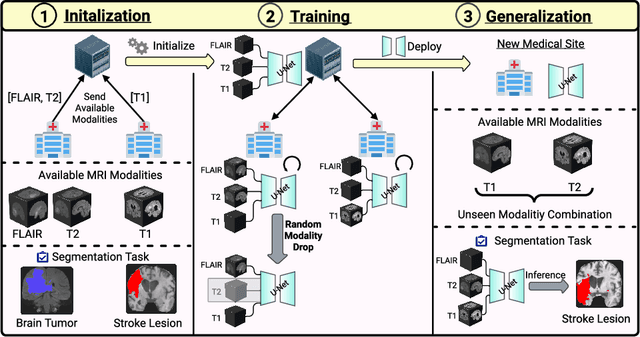



Abstract:Segmentation models for brain lesions in MRI are commonly developed for a specific disease and trained on data with a predefined set of MRI modalities. Each such model cannot segment the disease using data with a different set of MRI modalities, nor can it segment any other type of disease. Moreover, this training paradigm does not allow a model to benefit from learning from heterogeneous databases that may contain scans and segmentation labels for different types of brain pathologies and diverse sets of MRI modalities. Is it feasible to use Federated Learning (FL) for training a single model on client databases that contain scans and labels of different brain pathologies and diverse sets of MRI modalities? We demonstrate promising results by combining appropriate, simple, and practical modifications to the model and training strategy: Designing a model with input channels that cover the whole set of modalities available across clients, training with random modality drop, and exploring the effects of feature normalization methods. Evaluation on 7 brain MRI databases with 5 different diseases shows that such FL framework can train a single model that is shown to be very promising in segmenting all disease types seen during training. Importantly, it is able to segment these diseases in new databases that contain sets of modalities different from those in training clients. These results demonstrate, for the first time, feasibility and effectiveness of using FL to train a single segmentation model on decentralised data with diverse brain diseases and MRI modalities, a necessary step towards leveraging heterogeneous real-world databases. Code will be made available at: https://github.com/FelixWag/FL-MultiDisease-MRI
Feasibility and benefits of joint learning from MRI databases with different brain diseases and modalities for segmentation
May 28, 2024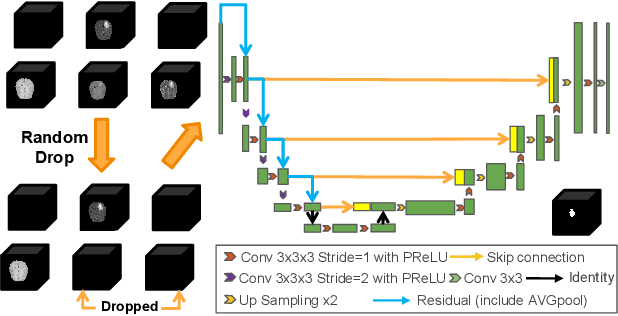
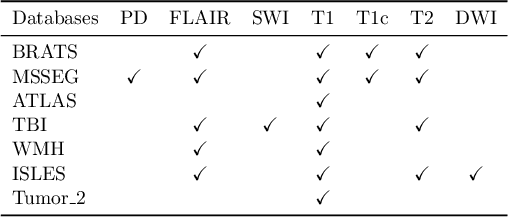


Abstract:Models for segmentation of brain lesions in multi-modal MRI are commonly trained for a specific pathology using a single database with a predefined set of MRI modalities, determined by a protocol for the specific disease. This work explores the following open questions: Is it feasible to train a model using multiple databases that contain varying sets of MRI modalities and annotations for different brain pathologies? Will this joint learning benefit performance on the sets of modalities and pathologies available during training? Will it enable analysis of new databases with different sets of modalities and pathologies? We develop and compare different methods and show that promising results can be achieved with appropriate, simple and practical alterations to the model and training framework. We experiment with 7 databases containing 5 types of brain pathologies and different sets of MRI modalities. Results demonstrate, for the first time, that joint training on multi-modal MRI databases with different brain pathologies and sets of modalities is feasible and offers practical benefits. It enables a single model to segment pathologies encountered during training in diverse sets of modalities, while facilitating segmentation of new types of pathologies such as via follow-up fine-tuning. The insights this study provides into the potential and limitations of this paradigm should prove useful for guiding future advances in the direction. Code and pretrained models: https://github.com/WenTXuL/MultiUnet
* Accepted to MIDL 2024
Examining Modality Incongruity in Multimodal Federated Learning for Medical Vision and Language-based Disease Detection
Feb 07, 2024Abstract:Multimodal Federated Learning (MMFL) utilizes multiple modalities in each client to build a more powerful Federated Learning (FL) model than its unimodal counterpart. However, the impact of missing modality in different clients, also called modality incongruity, has been greatly overlooked. This paper, for the first time, analyses the impact of modality incongruity and reveals its connection with data heterogeneity across participating clients. We particularly inspect whether incongruent MMFL with unimodal and multimodal clients is more beneficial than unimodal FL. Furthermore, we examine three potential routes of addressing this issue. Firstly, we study the effectiveness of various self-attention mechanisms towards incongruity-agnostic information fusion in MMFL. Secondly, we introduce a modality imputation network (MIN) pre-trained in a multimodal client for modality translation in unimodal clients and investigate its potential towards mitigating the missing modality problem. Thirdly, we assess the capability of client-level and server-level regularization techniques towards mitigating modality incongruity effects. Experiments are conducted under several MMFL settings on two publicly available real-world datasets, MIMIC-CXR and Open-I, with Chest X-Ray and radiology reports.
The built environment and induced transport CO2 emissions: A double machine learning approach to account for residential self-selection
Dec 07, 2023



Abstract:Understanding why travel behavior differs between residents of urban centers and suburbs is key to sustainable urban planning. Especially in light of rapid urban growth, identifying housing locations that minimize travel demand and induced CO2 emissions is crucial to mitigate climate change. While the built environment plays an important role, the precise impact on travel behavior is obfuscated by residential self-selection. To address this issue, we propose a double machine learning approach to obtain unbiased, spatially-explicit estimates of the effect of the built environment on travel-related CO2 emissions for each neighborhood by controlling for residential self-selection. We examine how socio-demographics and travel-related attitudes moderate the effect and how it decomposes across the 5Ds of the built environment. Based on a case study for Berlin and the travel diaries of 32,000 residents, we find that the built environment causes household travel-related CO2 emissions to differ by a factor of almost two between central and suburban neighborhoods in Berlin. To highlight the practical importance for urban climate mitigation, we evaluate current plans for 64,000 new residential units in terms of total induced transport CO2 emissions. Our findings underscore the significance of spatially differentiated compact development to decarbonize the transport sector.
A Causal Discovery Approach To Learn How Urban Form Shapes Sustainable Mobility Across Continents
Aug 31, 2023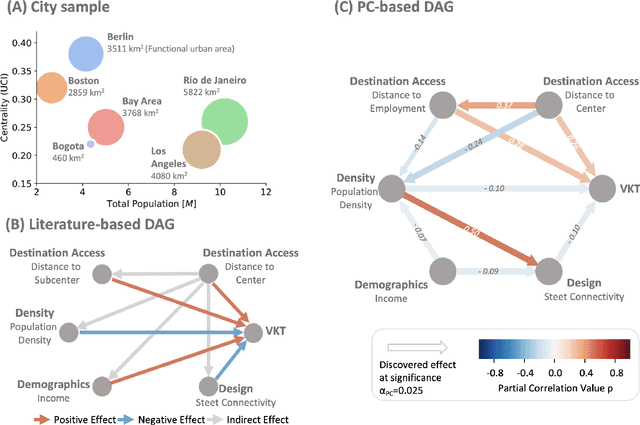

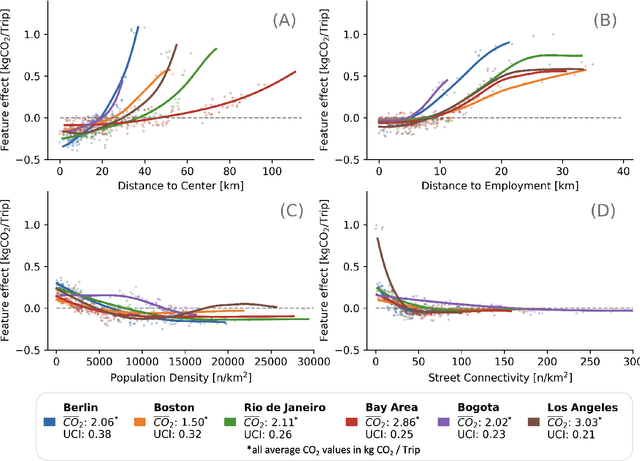

Abstract:Global sustainability requires low-carbon urban transport systems, shaped by adequate infrastructure, deployment of low-carbon transport modes and shifts in travel behavior. To adequately implement alterations in infrastructure, it's essential to grasp the location-specific cause-and-effect mechanisms that the constructed environment has on travel. Yet, current research falls short in representing causal relationships between the 6D urban form variables and travel, generalizing across different regions, and modeling urban form effects at high spatial resolution. Here, we address all three gaps by utilizing a causal discovery and an explainable machine learning framework to detect urban form effects on intra-city travel based on high-resolution mobility data of six cities across three continents. We show that both distance to city center, demographics and density indirectly affect other urban form features. By considering the causal relationships, we find that location-specific influences align across cities, yet vary in magnitude. In addition, the spread of the city and the coverage of jobs across the city are the strongest determinants of travel-related emissions, highlighting the benefits of compact development and associated benefits. Differences in urban form effects across the cities call for a more holistic definition of 6D measures. Our work is a starting point for location-specific analysis of urban form effects on mobility behavior using causal discovery approaches, which is highly relevant for city planners and municipalities across continents.
 Add to Chrome
Add to Chrome Add to Firefox
Add to Firefox Add to Edge
Add to Edge